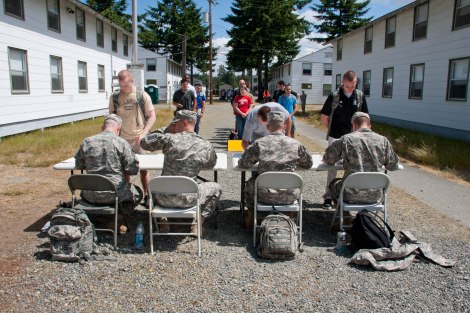
ROTC Cadets at the 2013 LDAC conduct in-processing June 14 at Joint Base Lewis-McChord, Wash. Throughout the summer over 6,000 Cadets will go through LDAC in-processing prior to taking part in training. U.S. Army photo by Heather Cortright.
Dozens of Reserve Officers’ Training Corps Cadets shifted from foot to foot, talking softly to each other and rustling their papers as they waited to leave the large tent. Some of them, like Cadet Dillon Kelley, Bravo Co., 2nd Regiment, had been waiting for an hour to continue in-processing at the Leader Development and Assessment Course at Joint Base Lewis-McChord, Wash. on June 14.
“You’ve got to keep from getting bored,” said Kelley. “That’s why I’m the only one reading.”
Because Kelley was awake since 3:30 a.m. and had been standing for most of those six hours, he said reading the TACSOP handbook that gives Cadets basic information they will need for the month was a good use of his time.
To begin in-processing, Cadets receive their orders, personnel record and other forms inside the tent. Groups of about 25 at a time leave the tent for the stats station. There, personnel confirm for the universities that the Cadets have arrived at LDAC. From that point, they go to the travel station, where personnel verify their orders and travel itinerary.
After signing out, the Cadets move to the medical tent to learn about preventative medicine, receive an ear inspection and divide into groups of flight Cadets, non-flight Cadets and consults. Their group determined what kind of physical they took.
Deputy Chief of Cadet Personnel Steven Remillard said the goal of in-processing is to get the Cadets through as quickly as possible.
“The less we have them here, the more time the regiments have them for training,” said Remillard.
Depending on the size of the regiment, Remillard said he hopes the process takes two or three hours, or no more than 15 minutes for each Cadet.
Travel Manager of Cadet Personnel Garrit Ringenoldus said they were moving slowly on the first day because everyone both Cadets and workers was new.
“By 13th Regiment, we’ll be cranking them out,” said Ringenoldus,
Until personnel work out the kinks, Cadets like Kelley may take longer than expected to go through in-processing.
“Just got to stay motivated through it,” said Kelley. “It doesn’t last long.”
Story by Monica Spees.
